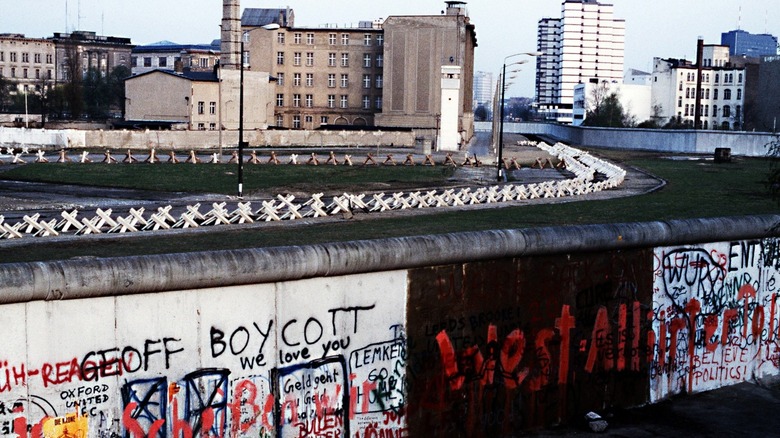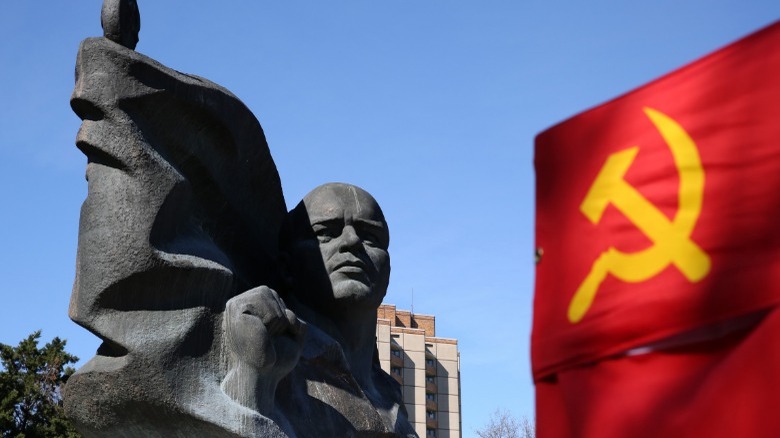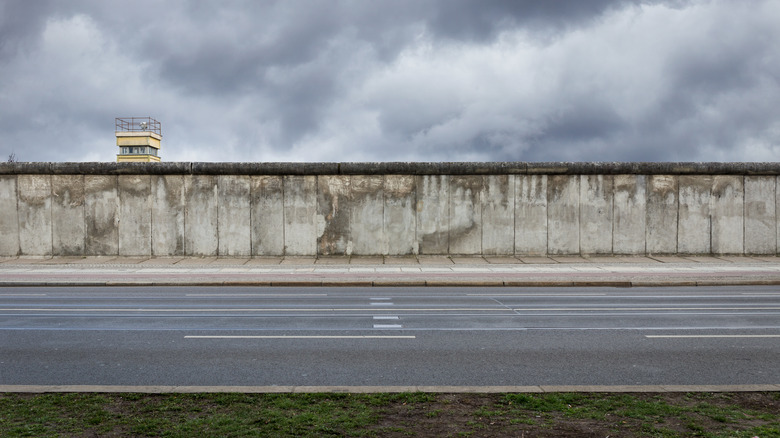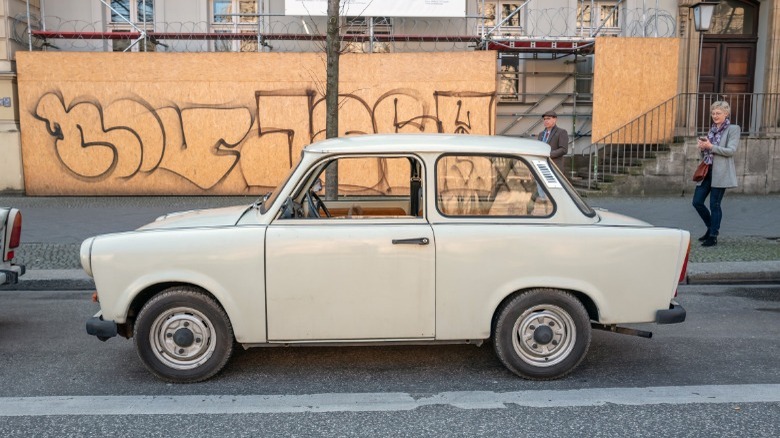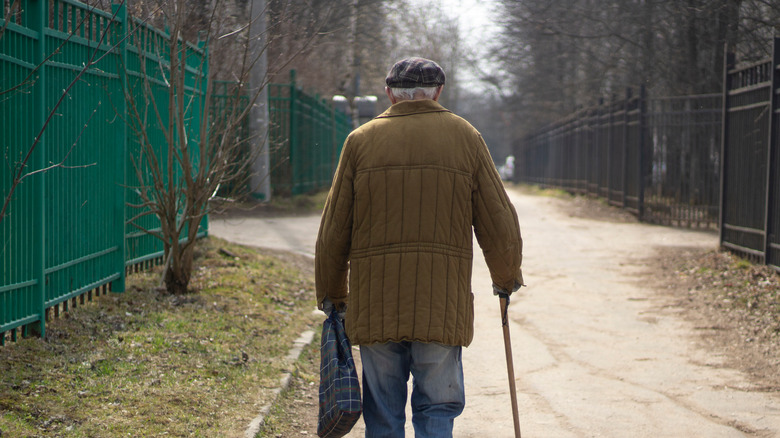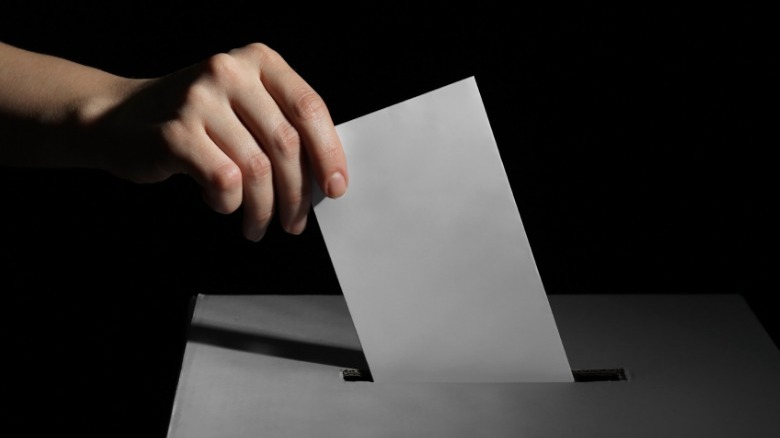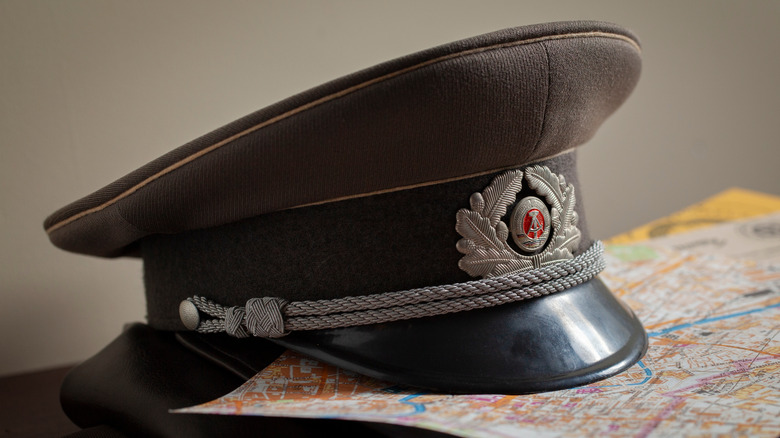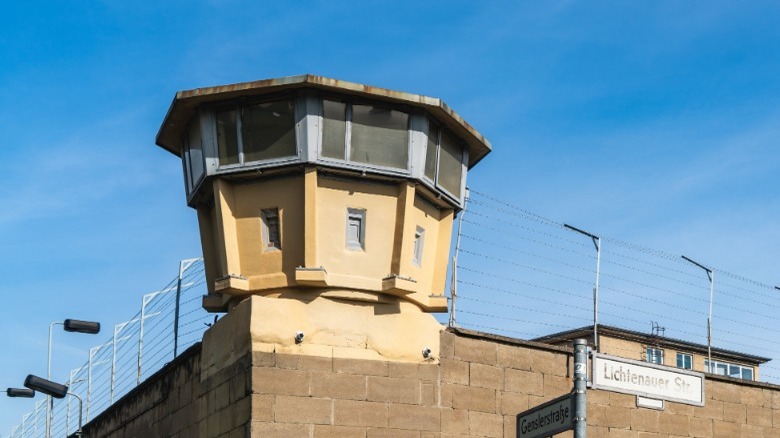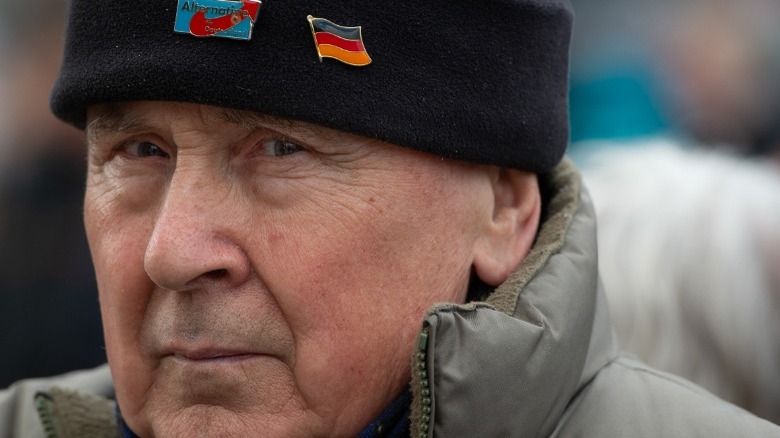What East Germany Was Like Before The Fall Of The Iron Curtain
The "Iron Curtain" is a metaphorical phrase popularized by Winston Churchill during his speech in Fulton, Missouri on March 5, 1946. Described by historian Robert Rhodes James as "a technical classic," the speech caused several phrases to enter common parlance, including "special relationship" and "the sinews of peace." It was Churchill's use of "Iron Curtain," however, that made the biggest impression. Some Russian historians consider this speech to signal the beginning of the Cold War.
In describing the political boundary that separated western capitalism and eastern communism, Churchill said, "A shadow has fallen upon the scenes so lately lighted by the Allied victory ... From Stettin in the Baltic to Trieste in the Adriatic, an iron curtain has descended across the Continent." Three years later, on October 7, 1949, the Soviet Union established the German Democratic Republic, commonly known as East Germany. This new communist state moved the Iron Curtain from Stettin, some 150 miles west, to the border of Lubeck in West Germany, which was established by France, Britain and the United States on September 21, 1949 (via Office of the Historian).
With this "Iron Curtain" between them, the two German republics became a case study for the strengths and weaknesses of the communist and capitalist models of society. By the time Germany reunified in October 1990, the lives of West and East Germans were starkly different.
East Germany had a centrally planned economy
A centrally planned economy is the bedrock of a communist state. In these societies, economic policy is decided by the government rather than consumers and businesses (via CCTV America). In the case of East Germany, the economy was decided by the Socialist Unity Party (SED), which ruled the country throughout its 40-year existence.
In this strictly top-down model, all parties, from workers to union leaders, were expected to achieve the SED's vision, and they were expected to do so with few if any incentives, according to Britannica. While West Germany enjoyed the so-called "German economic miracle" (per Econlib), East Germany's central planning caused widespread cynicism and disaffection that saw both the culture and the economy become stagnant and inert.
In an attempt to correct government inefficiency, a "grey market" was allowed to function for certain goods and services. For example, mechanics and general tradesman would offer better services for extra cash and other perks, while sales clerks had "under the counter" items for a price. These practices grew through the 1970s and '80s until reunification in 1990.
Economic growth was slower in the East than it was in the West
During the Third Reich, the states that would comprise East Germany had a per capita income that was 103% that of West Germany. However, this edge would see a dramatic reversal. By the fall of the Berlin wall, East Germany's per capita income was just 31% of West Germany (via Jaap Sleifer, quoted at the Foundation for Economic Education).
The evidence of this could be seen throughout East Germany's existence. In 1960, prominent economist B.R. Shenoy (posted at Libertarianism) visited East and West Berlin, which, like the wider country, had been split in half by Allied and Soviet forces. In the west, Shenoy observed that bomb damage from the Second World War was "virtually complete," while the main thoroughfares were "near jammed with prosperous looking automobile traffic." Jammed also were the department stores, which Shenoy described being full of "wearing apparel, other personal effects and a multiplicity of household equipment, temptingly displayed."
Shenoy's appraisal of East Berlin was quite different. The immediate difference was the bomb damage. "A good part of the destruction still remains," Shenoy wrote, adding that "twisted iron, broken walls and heaped up rubble are common enough sights." New structures were "drab pre-fabricated workers' tenements," and the cars, of which there were far fewer, were small and old. Shenoy concluded that his time in East Berlin was like "visiting a prison camp." Chenoy's startling anecdote reflected the data. This OECD chart shows the marked difference in gross domestic product per capita. In 1973, the West German figure was roughly $13,000 to East Germany's $7,800. By 1990, West Germany had reached over $18,000 per capita, while their eastern counterparts had approximately $9,000.
Corruption was widespread
Russian revolutionary and Soviet Premier Vladimir Lenin believed that corruption was a feature of late stage capitalism and that corruption would disappear with the spread and eventual predominance of communism (via Oxford University Press). In the late 1950s, East Germany's Socialist Unity Party echoed this sentiment, haranguing what they considered to be capitalism's "petty interest for private property, moral indifference, gangster practices and roughness of heart."
Both, however, were hypocritical. Lenin admitted to bribery, a widespread practice in the Soviet Union, and the German Democratic Republic quickly emerged as an inherently corrupt nation. Historians André Steiner and Kirsten Petrak-Jones identified nomenklatura as central to East Germany's corruption. German for nomenclature, which is defined as the taxonomic procedure of assigning names to groups of organisms, nomenklatura referred to the East German practice of each government position being confirmed by the next higher level, which meant that the General Secretery had the last word on all appointments. This arbitrary, cronyistic system was conducive to bribes and incentives, which were used to ensure loyalties in a country that had pretences of egalitarianism and dire shortages of goods and services.
Corruption was rarely reported or admitted, but as the German Democratic Republic fell, 39 court cases were levied against 53 GDR leaders, including former leader Erich Honecker. It is of little surprise that corruption manifested in East Germany's authoritarian collectivist system. According to the University of Toronto (reported in The Week), there is a relationship between collectivism and the acceptance of bribery, as collectivist systems lower perceptions of personal responsibility.
Media was censored
According to historian Robert Darnton (posted at Digital Access to Scholarship at Harvard), East Germany's constitution outlawed censorship. However, the reality was that the government controlled all forms of media, from film and TV to journalism and literature. Literature was overseen by the "Head Administration for Publishing and the Book Trade." Employee Hans Jurgen Wesener told Darnton that literature, in typical East German tradition, was planned like everything else. Wesener's department woud publish annual reports of all the literature that had been approved and published in the given year. The novels of the 1990 report, which ranged from thrillers and westerns and romance and war stories, were described by Darnton as "soap-opera" and "socialist kitsch."
The annual reports would also establish publishing agendas. For example, during the 40th anniversary celebrations in 1989, the government used literature to promote the "historical mission of the working class in the struggle for social progress." Sentiments and standards were set not by Hans Jurgen Wesener but by the Central Committee's Culture Division, which consisted of 15 "hard-bitten ideologues."
The press was in a simillarly dire place until the Berlin Wall fell in November 1989, when, for a few short weeks, journalists enjoyed what historian John Sandford (in Journal of Contemporary European Studies, posted at Taylor & Francis Online) described as "a degree of freedom almost without parallel anywhere in the world," as they had a fully functioning media sans the censorship that had blighted their profession. For the first time in 40 years, newspapers were able to report corruption of the state, unions, and party officials.
East Germany had inferior technology
The Trabant automobile was a microcosm of East German technological inferiority. The first "Trabi" rolled off the production line on November 7, 1957, and it became a huge success despite being made of Duroplast, a hard plastic composed of pressed cotton fibers, synthetic resins, and rags from the Soviet Union (via Deutsche Welle).
Jokingly dubbed the "running cardboard," the "plastic bomber," and the "Saxon Porsche," the Trabant's success was due to there being very few alternatives for East German consumers. Engineers proposed upgrades to the car, but government officials spurned such notions of innovation. Soon, East Germany's car industry was far behind its western counterpart, which became famous for both luxury cars and mass market motoring, typified by the iconic Volkswagen Beetle, which was the Trabant's western equivalent.
Writing at Autotrader in 2016, motoring journalist Doug DeMuro did not mince words in his review of a 1981 Trabant. "The Trabant is loud, slow, poorly designed, badly built, tremendously inhospitable to drive, ancient, uncomfortable, confusing and inconvenient. If I were giving it stars, it would earn zero; if I were giving it thumbs, I'd have mine surgically removed before putting them up for the Trabant."
Most consumer goods were loathed and avoided, but some have made a comeback
During B.R. Shenoy's trip to East Berlin, the economist observed how the shops exhibited "cheap articles in indifferent wrappers or containers and the prices for comparable items, despite the poor quality, are noticeably higher than in West Berlin." Shenoy's appraisal in 1960 would be relevant for the rest of East Germany's existence. In 1978, The Washington Post wrote of how citizens flocked to stores specializing in West German consumer goods, which were so popular that they generated some $40 million a year. Twelve years later, in 1990, United Press International reported that the government had slashed prices in attempt to stimulate the economy; many citizens refused to buy badly made domestic products as the countries began to unite.
In the 1990s, West German products supplanted many eastern counterparts, and many were happy about that. "I wouldn't really want to have any of the old East German chocolate again," joked Nils Busch-Petersen, a former East Berliner (via Deutsche Welle). However, not all East German brands fell with the wall. Sparkling wine maker Rotkäppchen went from strength to strength, buying its main rival in 2002 and comprising 40% of Germany's sparking wine market.
In fashion, a socialist chic has emerged, with Zeha sneakers being especially cool. "I always had a pair," said Torsten Heine, who relaunched the brand in the 2010s. He told Deutsche Welle, "It was forbidden to wear them in your spare time because it was difficult to get a pair, but we did anyway because it was cool."
Citizens had a lower life expectancy than their western counterparts
During the 1950s and '60s, life expectancy was broadly similar between East and West Germany. However, by the 1970s, there was a marked rise among the West German population because the German Democratic Republic, like many of the Iron Curtain nations, struggled to reduce circulatory diseases among the elderly (via Population Health Metrics). Remarkably, between 1990 and 2009, the former states of East Germany saw a rise of 6.3 years among women and 7.4 years among men. While East Germany's life expectancy was neither static nor negative, it would have grown at a markedly lower rate. According to the University of Rostock, if the German states had remained divided, life expectancy at birth among East Germans would be 4.0 years lower for women and 5.7 years lower for men.
In 2015, Max-Planck-Gesellschaft reported that after 25 years of reunification, life expectancy among women had almost levelled. Researchers Sebastian Klüsener and Rembrandt Scholz observed that the gap was mere months, with western women living to an average of 82.8 years and eastern women living lives slightly shorter, at 82.6 years.
Another telling statistic were the respective population sizes. A larger territory, West Germany was always going to have a greater number of people. Yet the trajectories said a lot about each country's desirability. In 1950, East Germany had a population of 18.3 million. By 1990, it was just over 16 million. During that same period, West Germany's population went from 50.9 million to 63.7 million (via Statista).
Elections were not free
In an article about Stalin's creation of the Socialist Unity Party of Germany, posted by the National World War II Museum, historian Robert Citino wrote, "Stalin paid lip service to concepts like 'democracy,' 'free elections,' and 'governments responsive to the will of the governed.' But he had no intention whatsoever of pursuing those lofty ideals. He intended to communize Eastern Europe."
Stalin died in 1953, but the Socialist Unity Party lived on, governing East Germany throughout the vast majority of its 41-year statehood. There were other parties, such as the National Democratic Party of Germany and the Democratic Farmer's Party of Germany, but these, according to historian Frank B. Tipton's book "A History of Modern Germany since 1815," were "without real power" and were tolerated only to "deflect criticism that this was a one party state."
East Germany had its first fully democratic election in March 1990, which saw the Socialist Unity Party, led by Hans Modrow, voted out of office (via Deutsche Welle). Modrow lost to Lothar de Maizière, leader of the East German Christian Democratic Party.
Citizens were spied on by the Stasi secret police
According to Britannica, the Stasi secret police force was one of the most hated and feared institutions of the East German government. Stasi operatives were tasked with infiltrating "dissidents" through extensive surveillance methods. Wiretaps were a favorite tool, but the Stasi also relied upon informants and collaborators to do their bidding, unearthing all the information they could, from the professional to the personal and familial. By 1989, the Stasi had as many as 2 million collaborators, sowing much paranoia in East German life.
The Stasi's obsession with control went to ludicrous extremes. According to Philipp Springer's "Der Blick der Staatssicherheit" ("The Gaze of State Security"), a book about East German life (reviewed by The Guardian), a security incident occurred when three children kicked a football over the Berlin Wall onto East German soil. The ball was returned only after a report was written and photos taken. But the Stasi was no joke. It would tail and harrass its targets relentlessly, generating as many as 1 billion pages of surveillance records, informant accounts, espionage reports, and many other documents (via Wired). Much like the Gestapo, their Nazi forebears, the Stasi would kill, too. According to The Guardian, West German police believed that the Stasi had a secret death squad that operated with a "licence to kill," assassinating at least 25 people.
In 2009 (per Deutsche Welle), Chancellor Angela Merkel visited a former Stasi prison. Merkel, who grew up in East Germany, said, "This memorial makes clear in an authentic setting in what brutal ways the dignity of human beings was damaged, and how lives were destroyed and torn apart for trivial reasons."
To flee was to risk death
Images of Berliners fleeing the east became iconic, especially that of border guard Conrad Schumann, whose frantic dash across barbed wire made international headlines (via Independent). Schumann's actions risked death, but the 19-year-old noncommissioned officer could not tolerate life in the east. "My nerves were at breaking point. I was very afraid. I took off, jumped, and into the car ... in three, four seconds it was all over" (via Independent).
When government archives were opened to the world after the fall of the Berlin Wall, the full extent of East Germany's murderous border control was laid bare. According to a 1992 report by the Victoria Advocate, as many as 350 people were killed for trying to flee the East German state.
Many East Germans successfully fled to west, but it was a painful decision. B.R. Shenoy observed (posted at Libertarianism), "The emigrants have to leave behind all their assets, save the clothing they wear and such valuables as they may carry unobtrusively." Despite this great sacrifice, scores of people thought it a risk worth taking, with the urge to leave greatest "among technicians, professional men and intellectuals."
The Iron Curtain may have fallen, but the divide remains
The Iron Curtain may have descended over 30 years ago, but a divide persists to this day. According to Pew, 74% of people in the former East German states feel that they have caught up with the west. Furthermore, 57% of East Germans feel like second-class citizens (via The Guardian). These perceptions are corroborated by numerous statistics. GDP per capita remains 20% lower in the east than the west. Lower also are salaries and wages, which are still at a 15% deficit compared to the west. Unemployment is another disparity, with western Germany reporting a rate of 4.8% and their eastern counterparts 6.9%.
A split is evident in politics, too. According to Politico, the Green party has made significant gains across western Germany. By contrast (per Deutsche Welle), the former East German states have been a linchpin for the far-right populist party Alternative for Deutschland (AfD). Commenting on this phenomenon, Christian Democratic Union politician Marco Wanderwitz said (via Foreign Policy), "We are dealing with people who are partially socialized by dictatorship in such a way that they have not reached democracy, even after 30 years."
On the 31st anniversary of reunification (per another report by Deutsche Welle), former East German Chancellor Angela Merkel sought to build bridges between east and west: "We know that the answer is in our hands, that we have to listen and speak with each other, that we have differences, but above all things in common."
